Abstract
This article presents a contemporary overview of soft or compliant denture lining materials. It does not focus on denture bases, which are intrinsically flexible, and suggests some clinical options which readers might wish to consider.
From Volume 38, Issue 2, March 2011 | Pages 102-104
This article presents a contemporary overview of soft or compliant denture lining materials. It does not focus on denture bases, which are intrinsically flexible, and suggests some clinical options which readers might wish to consider.

Denture bases tend, in the main, to be constructed of metal (cobalt-chromium alloy, gold alloy or, more recently, titanium) or a polymeric material, typically polymethyl methacrylate. More recently, bases made of superpolyamide have been developed, bases that were earlier on nylon-based thermoplastics, but these lack clinical research data to discuss further.
Polymethyl methacrylate (PMMA) is used extensively where complete dentures are prescribed and, in cases of severe atrophy of the residual ridges and the overlying mucosa, consideration is given to a reduction in the load of the denture-bearing tissues by the use of a compliant (soft) lining. Such a lining may be temporary, to permit traumatized tissues to return to normal prior to constructing replacement dentures, or definitive (the word permanent suggests a longevity not normally clinically achievable or, indeed, advisable). Indeed, these compliant linings have proven so popular among such patients that clinical experience would suggest that, once patients embark on the wearing of a definitive compliant lining, the chances of success with a conventional PMMA denture base without such a lining are low.
From the above, therefore, there are two categories of compliant lining material that will be discussed in this article:
These materials enjoy popularity in the treatment of denture stomatitis, after pre-prosthetic surgery and in the transitional treatment of patients with denture base-associated problems (Figures 1, 2 and 3). Tissue conditioners are (temporarily) applied to the ‘fitting’ or impression surface of the denture and, as they can be removed relatively easily, constitute a reversible form of treatment. They function essentially as a cushion between the denture base and the patient's soft tissues overlying the bony component(s) of the denture-bearing area. Such materials are intended to remain soft during use, thereby reducing trauma to the underlying soft tissues. They are therefore required to demonstrate appropriate rheology, initially to conform to the peridenture musculature, thereafter the linings should demonstrate resistance to further deformation. Conditioning compliant lining materials generally comprise a powder:liquid system as is illustrated in Table 1.
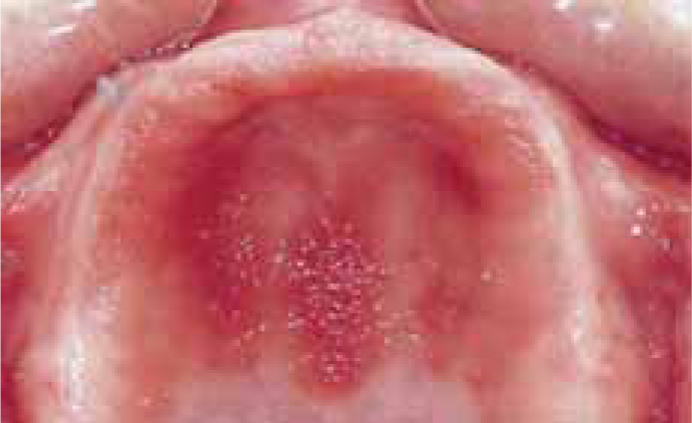


| Form | Descriptors | Common Trade names |
|---|---|---|
| Powder | Beads of polyethyl methacrylate |
Coe Comfort |
| Liquid | Solvent (ethyl alcohol) |
Visco-Gel |
When used to ‘reline’ the dentures, the powder is added to the liquid and stirred until a gel-like consistency is achieved comprising expanded and plasticized polymer beads in a matrix of a suspension of polymer in an admix of solvent in plasticizer. The inherent softness of each manufactured material will depend on the percentage composition of plasticizer and solvent (vide infra).
The mixed material is added to the denture(s) to be modified and the patient asked to close lightly into occlusion (as, indeed, one should with all reline/rebasing techniques). When the material has set, and on removal from the mouth, an even layer of material should be evident over the impression surface of the denture, to ensure no inherent support problems are going to be induced.
As was mentioned earlier, these materials are, by nature, temporary owing to the fact that, in time, the alcohol and the plasticizer leach out into the mouth and the materials become less soft; indeed, after a time such linings may become roughened and promote the colonization of micro-organisms. For this reason, it is recommended that they be replaced at least weekly.1
These materials come in a variety of preparations (Figure 4) and some of these conditioning lining materials may exhibit enough thixotropicic flow/displaceability as to be useful as a functional impression material in addition to acting as a tissue conditioner. An example of this is Visco-Gel™ which may be used advantageously as a functional impression in those awkward clinical cases where muscle attachments result in denture instability owing to the fact that conventional impression materials are not by nature dynamic in the way they record tissue displacement. These materials, when added to the periphery of a prepared denture, and when left to flow under pressure (thixotrophy), can reproduce the dynamic nature of the denture periphery and hence enable the denture to be relined to a more stable form (Figure 5).
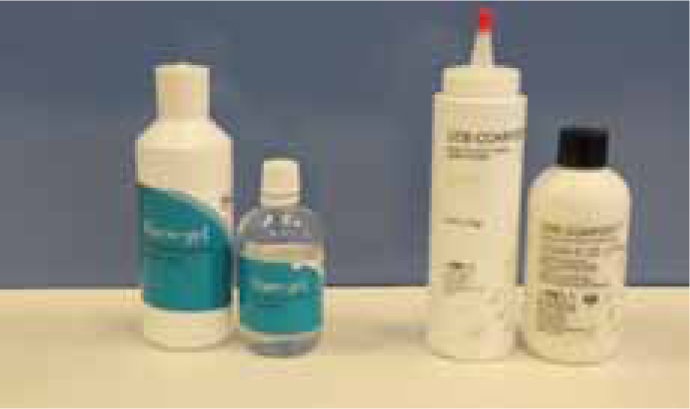
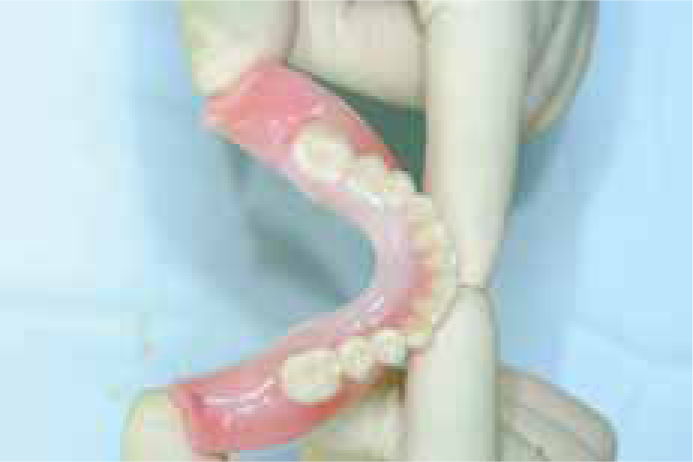
An added advantage to the use of such materials is the report that master casts poured from such impressions exhibited excellent surface hardness.2
Most readers will have experience of edentulous patients who have atrophic ridges and/or friable mucosa overlying the denture-bearing areas. For such patients, denture wearing may be vexing and eating severely problematic. In such cases, especially when implant-stabilized/supported prostheses are not an option, clinicians have to seek to make denture-wearing more tolerable by the prescription of a denture (typically a mandibular denture) with a compliant resilient lining. The philosophy behind their usage is that forces of mastication are absorbed by the compliant lining material rather than being transferred via the denture base to the underlying tissues. It should be pointed out that such linings do not eliminate stresses on the mucosa but are intended to result in a more even distribution of stresses at the ‘ultimate sandwich area’ – the interface between the mucosa and the denture base.3 In consequence, these materials should exhibit the following requirements:
It is also desirable that they have the ability to resist ingrowth of opportunistic micro-organisms.
In essence, there are two subdivisions of definitive compliant lining materials and each subdivision may be further divided into heat (H) and room temperature (RT) polymerized (cured) forms, as is outlined in Tables 2 and 3. The former are processed in the dental laboratory, while the latter may be used as ‘chairside’ reline materials.
| Material Type | Constituents |
|---|---|
| Acrylic (H and RT) | Powder: polyethyl or polybutylmethacryate powder and a pigment. |
| Silicone rubber (H and RT) | One paste containing polydimethyl siloxane and an initiator (peroxide) which breaks down and initiates cross-linking. |
| Material | Chairside (RT) | Laboratory (H) |
|---|---|---|
| Acrylic | UnoDent Denture Reline (soft) | Permasoft |
| Silicone rubber | GC Reline | Molloplast B |
While none of these materials can be considered ‘permanent’, some are more definitive than others; the RT materials ought to be considered as transitional at best. In addition to their chemistry, one noteworthy difference between the acrylic and the silicone rubber linings processed under heat is that these linings will only ‘bond’ to newly processed acrylic resin, hence reline/rebase techniques are required in the laboratory. Clinicians should be wary, however, of the potential of these linings to flow under pressure into areas where flow is not recommended. Of particular concern is where the mental nerves are palpable; in these cases, it is recommended that the clinician instructs the technician to block out the appropriately indicated areas of the master cast with tin foil to preclude such a happening (Figure 6).
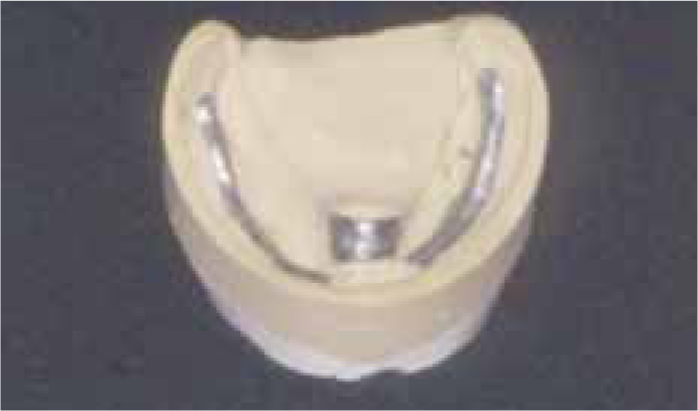
In addition to their use as a compliant lining material, the physical properties inherent in the heat-processed silicone rubber materials may be advantageously employed clinically in two other ways.
The first is to be used to engage bony undercuts, eg in those cases where there are large bony tuberosities or exostoses.4 Prudent placement of the compliant material will ensure that the optimal restoration of the peripheral roll is achieved (thereby maximizing peripheral seal) at the same time eliminating trauma to the soft tissues overlying the bulbous bony areas (support) (Figure 7).

The second instance is in cases with few remaining teeth and two examples may be cited here. The first relates to those cases where there are only a few teeth remaining and where it is considered that their loss is imminent. In such cases, a velum of silicone rubber may be used to circle the remaining teeth and provide an effective peripheral seal (the only time a peripheral seal is achievable in a partial denture). An extension to this is the example where anterior teeth are missing and the silicone rubber addition may be used to engage anterior undercuts, thereby enhancing direct retention and, further, enhancing aesthetics by giving the appearance of the ‘lost’ interdental papilla (Figure 8).
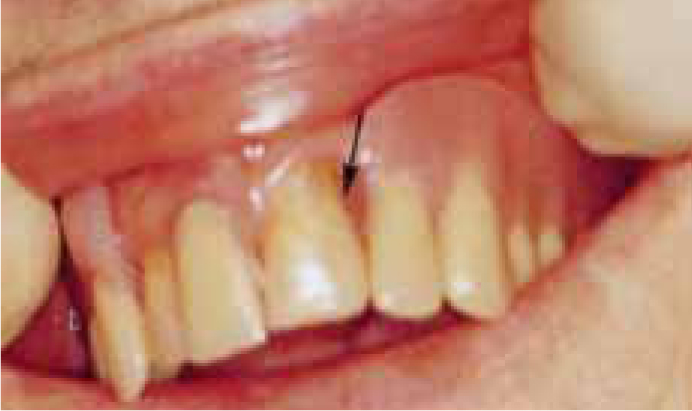
In 1995, Braden and co-workers stated that, in their opinion, there was a substantial misunderstanding of the function and properties of compliant linings among dental practitioners;5 one suspects that this statement still rings true.
The conclusion by Braden and co-workers that there was no ideal compliant lining is still a valid statement. This may be because no such material can adequately mimic the function of oral soft tissues. Further, clinicians (and patients) have to realize that complete dentures cannot replicate full oral function of dentate patients and this inability to replicate oral (masticatory) function is inversely proportional to the degree of atrophy of the denture-bearing tissues. While the 2003 Toronto Consensus Conference indicated that a ‘gold standard’ for edentulous people would be an implant-stabilized mandibular denture, this cannot be offered to many people. Those with tender residual ridges who must suffer the problems of painful and reduced oral function therefore rely on the use of compliant linings to their dentures and, for that reason, there ought to be a determined effort to create improved materials.